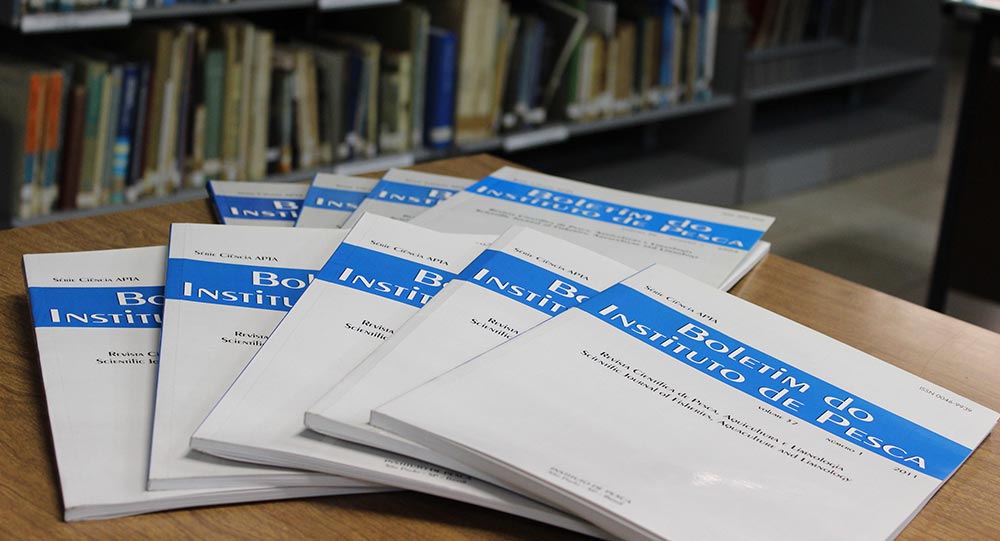Efeito da intensidade luminosa sobre o crescimento de juvenis do linguado Paralichthys orbignyanus
Palavras-chave:
fator abiótico, piscicultura marinha, berçário de peixes, PleuronectifomesResumo
A maioria dos peixes necessita de ambiente com intensidade luminosa mínima para o seu desenvolvimento e crescimento. O objetivo do presente estudo foi avaliar o efeito da intensidade luminosa sobre o crescimento de juvenis do linguado Paralichthys orbignyanus. Juvenis de 1,55 ± 0,03 g foram distribuídos aleatoriamente em 12 tanques de 50 L (75 peixes por tanque). As intensidades luminosas testadas foram 5 (5 ± 1 lux), 180 (176 ± 6 lux), 700 (712 ± 29 lux) e 2.000 lux (1.998 ± 64 lux), todas em três repetições. Durante 42 dias, os peixes foram alimentados com ração comercial até a saciedade. A salinidade foi mantida em 32 g L-1, a temperatura em 23°C, o oxigênio dissolvido em 6,6 mg L-1, o pH em 7,8 e a amônia não ionizada em 0,01 mg L-1 NH3-N. Ao final do experimento, os juvenis mantidos sob 5 e 180 lux apresentaram respectivamente 10,1 ± 0,3 e 9,44 ± 0,3 g, pesos superiores aos dos juvenis mantidos sob 700 lux (8,45 ± 0,3 g) e 2.000 lux (8,44 ± 0,3 g) (P<0,05). A taxa de crescimento específico diário foi maior sob 5 lux (4,6 ± 0,2%), quando comparada í s obtidas sob 700 lux (4,0 ± 0,1%) e 2.000 lux (4,0 ± 0,1%) (P<0,05), enquanto que a obtida sob 180 lux (4,3 ± 0,1%) não diferiu de nenhuma (P>0,05). A sobrevivência foi de 100% em todos os tratamentos. De acordo com os resultados obtidos, juvenis de linguado devem ser criados entre 5 e 180 lux.
Referências
feeding methods and light regimes of the African catfish (Clarias gariepinus) juveniles.
Aquaculture, 231(1-4): 347-359.
APHA 1998 Standard methods for the examination of water and wastewater. Washington: American Public Health Association. 1193p.
BIANCHINI, A.; ROBALDO, R.B.; SAMPAIO, L.A. 2010 Cultivo do linguado (Paralichthys orbignyanus). In: BALDISSEROTTO, B. and GOMES, L.C.Espécies nativas para a piscicultura no Brasil.Editora da Universidade Federal de Santa Maria,Santa Maria. p.559-587.
BOEUF, G. and BAIL, P.Y. 1999 Does light have an influence on fish growth? Aquaculture, 177(1-4):
129-152.
DÍAZ DE ASTARLOA, J.M. 2002 A review of the flatfish fisheries of the South Atlantic Ocean.
Revista de Biología Marina y Oceanografía, 37(2):113-125.
FIGUEIREDO, J. and MENEZES, N. 2000 Manual de peixes marinhos do sudeste do Brasil (vol. VI). São Paulo: Museu de Zoologia - Universidade de São Paulo. 116p.
FISCHER, L.G.; PEREIRA, L.; VIEIRA, J. 2011 Peixes estuarinos e costeiros (2nd ed.). Rio Grande. 130p.
HAN, D.; XIE, S.Q.; LEI, W.; ZHU, X.; YANG, Y. 2005 Effect of light intensity on growth, survival and
skin color of juvenile Chinese longsnout catfish (Leiocassis longirostris Günther). Aquaculture,
248(1-4): 299-306.
LIU, Y.; MOU, Z.; XU, G.; LI, Y.; WANG, C. 2012 The effect of light intensity on the growth of
Brachymystax lenok (Pallas, 1773). Aquaculture Research, 43(12): 1838-1844.
LOUZADA, L.R. 2004 Efeito do fotoperíodo na sobrevivência e crescimento de larvas e juvenis do
linguado Paralichthys orbignyanus. Rio Grande. 33p. (Master’s Dissertation. Universidade
Federal do Rio Grande). Available at: <http://www.argo.furg.br/?BDTD83> Access on:
13 Nov. 2014.
LUCHIARI, A.C.; MORAIS FREIRE, F.A.; KOSKELA, J.; PIRHONEN, J. 2006 Light intensity preference of juvenile pikeperch Sander lucioperca (L.). Aquaculture Research, 37(15): 1572-1577.
MARCHESAN, M.; SPOTO, M.; VERGINELLA, L.; FERRERO, E.A. 2005 Behavioural effects of artificial light on fish species of commercial interest. Fisheries Research, 73(1-2): 171-185.
MacINTOSH, K.E. and DUSTON, J. 2007 Effect of light intensity and eye development on prey
capture by larval striped bass Morone saxatilis. Journal of Fish Biology, 71(3): 725-736.
NASH, R.D.M.; VALENCIA, A.H.; GEFFEN, A.J 2006 The origin of Fulton’s condition factor -
setting the record straight. Fisheries, 31(5): 236-238.
NELSON, J.S. 2006 Fishes of the world (4th ed.). Hoboken: John Wiley & Sons, Inc. 601p.
ODEBRECHT, C.; BERGESCH, M.; MEDEANIC, S.; ABREU, P.C. 2009 A comunidade de microalgas.
In: SEELIGER, U. and ODEBRECHT, C. O Estuário da Lagoa dos Patos: um século de
transformações. Editora da FURG, Rio Grande.p.51-63.
PEKCAN-HEKIM, Z. and HORPPILA, J. 2007 Feeding efficiency of white bream at different
inorganic turbidites and light climates. Journal of Fish Biology, 70(2): 474-482.
RADONIC, M.; MíÅ“LLER, M.I.; LÓPES, A.V.;BAMBILL, G.A.; SPINED, M.; BOCCANFUSO, J.J. 2007 Avances en la reproducción controlada del lenguado Paralichthys orbignyanus en Argentina. Ciencias Marinas, 33(2): 187-196.
SAMPAIO, L.A.; ROBALDO, R.B.; BIANCHINI, A. 2008 Hormone induced ovulation, natural
spawning and larviculture of Brazilian flounder Paralichthys orbignyanus (Valenciennes, 1839).
Aquaculture Research, 39(7): 712-717.
SOKAL, R.R. and ROHLF, E.J. 1995 Biometry: the principles and practices of statistics in biological
research. 3ª ed. New York: WH Freeman Publish.887p.
STRICKLAND, J.D.H. and PARSONS, T.R. 1972 A practical handbook of seawater analysis. Ottawa.
310p
TAO, W.; YONGZHOU, C.; ZHAOPU, L.; SHAOHUA, Y.; XIAOHUA, L. 2013 Effects of light intensity
on growth, immune response, plasma cortisol and fatty acid composition of juvenile
Epinephelus coioides reared in artificial seawater. Aquaculture, 414-415: 135-139.
TRIPPEL, E. and NEIL, S. 2003 Effects of photoperiod and light intensity on growth and
activity of juvenile haddock (Melanogrammus aeglefinus). Aquaculture 217(1-4): 633-645.
UNESCO 1983 Chemical methods for use in marine environmental monitoring. Paris. 53p.
VILLAMIZAR, N.; BLANCO-VIVES, B.; MIGAUD, H.; DAVIE, A.; CARBONI, S.; SÁNCHEZVÁSQUES, F.J. 2011 Effects of light during early larval development of some aquacultured teleosts: A review. Aquaculture, 315(1-2): 86-94.










